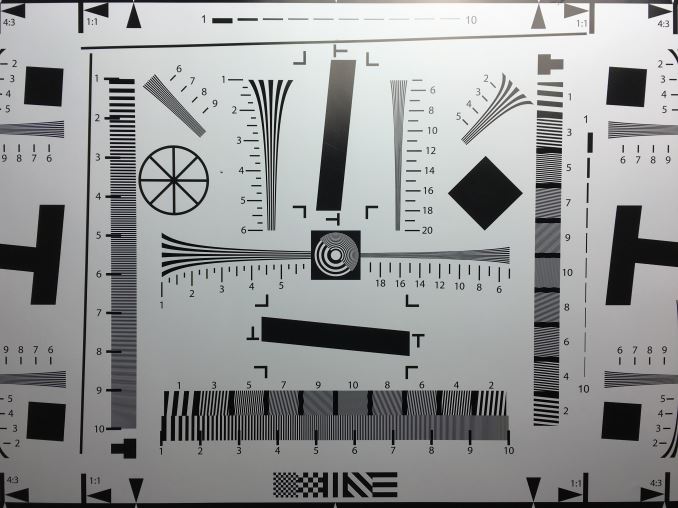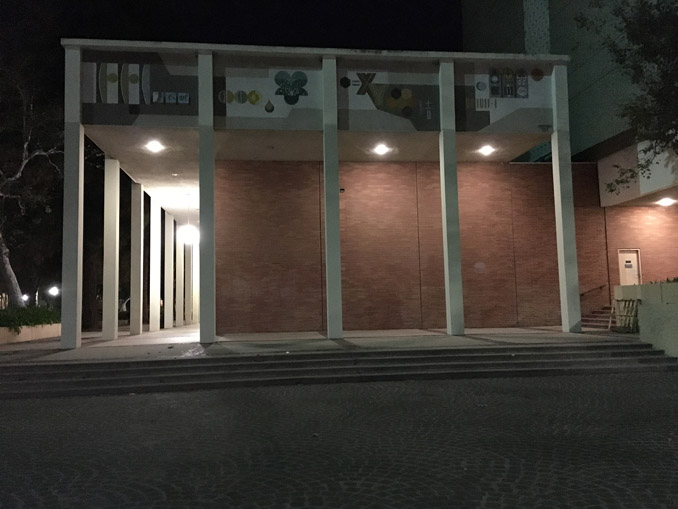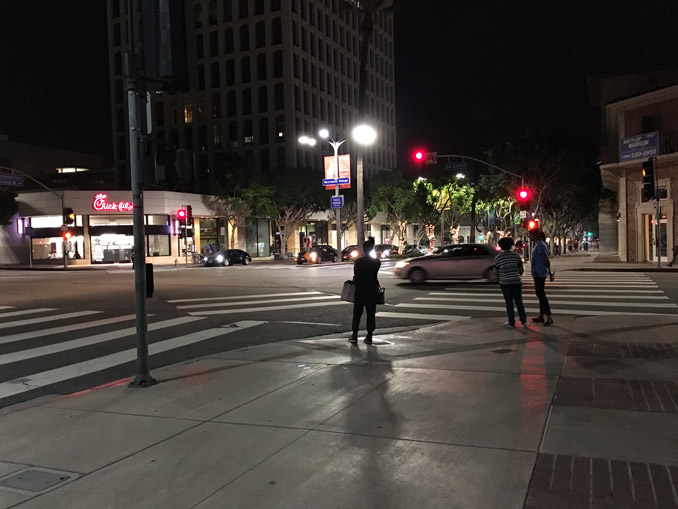The Apple iPhone 6s and iPhone 6s Plus Review
by Ryan Smith & Joshua Ho on November 2, 2015 8:00 AM EST- Posted in
- Smartphones
- Apple
- Mobile
- SoCs
- iPhone 6s
- iPhone 6s Plus
Still Image Performance
Now that we’ve discussed the user experience and still image quality we can start to compare the end result after taking photos. For those unfamiliar with how we test photos, we rely on a combination of controlled lighting tests and relative real-world comparative tests. In the interest of better-controlled testing I’m hoping to make a move towards more controlled testing in the future but for now relative comparisons in mostly identical conditions should give a pretty good idea for what to expect from a camera.
Looking at our standard resolution test, the iPhone 6s has visibly more detail than the iPhone 6, but we're basically looking at the ideal case here. Both phones have some noticeable haloing around high-contrast edges to enhance perceived sharpness but the iPhone 6s manages to keep smoother edges in the image and less distortion of the closely spaced line pairs in the center of the image. Given how subtle some of these changes are I suspect that in real-world situations it would be difficult to tell the difference between the iPhone 6s and iPhone 6 for overall image detail.
| Daytime Photography |
Our first real-world test is a daytime shot. Compared to something like the iPhone 6 in this test, oddly enough there isn’t a huge improvement, which suggests that either that noise reduction is reducing overall detail in the image or that the optics are actually the limiting factor in resolution. The Note 5 does hold an advantage here by virtue of larger sensor size and just more pixels to work with. However when compared to some of the other phones on the market like the One M9 Apple actually manages to produce a better image despite their sensor size deficit and pixel count deficit.
The same scene with HDR enabled shows that Apple is relatively conservative when it comes to how strong they make their HDR effects. Once again something like the Note 5 is clearly better here when it comes to detail and overall dynamic range, but Samsung does push a bit too far when you look at some shadows as the trees in the left half of the image have noticeable color artifacts. Interestingly enough, LG is the clear leader here when it comes to dynamic range and detail but they do have a problem with some excessive sharpening and some color artifacts when we look at some really extreme long distance detail. Apple does need to improve HDR here, as the latency for an HDR photo is quite long and the difference between HDR on and off is rather subtle in situations where it shouldn't be subtle.
| Low Light Scene 1 |
Moving on to the same scene shot in low light, it’s almost kind of shocking to say this but the iPhone 6s is better than the iPhone 6 here in low light. However, this does come at the cost of more visible luminance noise which suggests that we’re looking mostly at differences in post-processing. The same is true of the iPhone 6s Plus when compared to the iPhone 6 Plus, which is kind of surprising but given that in low light we’re mostly limited by the sensor rather than the available light it makes sense that sensor-level improvements eliminate the disadvantages associated with small pixel sizes.
Relative to the Galaxy Note 5, the iPhone 6s Plus is pretty close here but the Note 5 does have an edge in detail. However, the post-processing has noticeably more artifacts such as the odd streak on the left side of the image which is due to stray light. The iPhone 6s Plus also does a better job of freezing motion of the people walking on the stairs, which is likely due to their image combination techniques to reduce motion blur that would otherwise be evident due to the long exposures used. The G4 might look better to some people but detail is similar to the iPhone 6s Plus with the motion blur of the Note 5, so it ends up behind both.
| Low Light Scene 2 |
In the interest of gathering more data points for low light camera performance, I decided to try and find a relatively uniform low light scene that stresses detail more strongly. Here, once again the iPhone 6s and 6 are pretty similar but the iPhone 6s has better detail at the expense of more noise. Relative to the iPhone 6 Plus, the iPhone 6s Plus ends up with better detail as well. The iPhone 6s Plus is actually arguably better than the Note 5 here by virtue of more accurate color and better details. For whatever reason in some very low contrast areas Samsung is just blurring away details in their post-processing that Apple is retaining. The ground is clearly more detailed as well. This seems counter-intuitive but this is really just Apple’s processing here as they’re getting away with an absurdly long exposure time without the associated motion blur that you might expect from a quarter second exposure. Once again, the LG G4 actually manages to beat the Note 5 and iPhone 6s Plus in absolute detail here despite the much higher sensor gain selected for this scene. The OnePlus 2 in this scene looks pretty similar to the iPhone 6s Plus, but with more color noise and a bit more blur at 100%.
| Low Light Scene 3 |
In the interest of breaking things down even more, I decided to do one last low light test scene which is really more designed to see what motion blur occurs in low light than anything else. This is far from scientific but the iPhone 6s and 6s Plus are once again effectively equivalent at freezing motion, while the Note 5, G4, and almost every other phone I attempted to test this scene with is visibly worse at this. Weirdly enough, even though the Moto X 2014 and iPhone 6s are using the same shutter speed the iPhone appears to do a better job of maintaining detail. This is likely due to changes in image processing on the software side to try and reduce the effects but this is a rough estimate as I can’t control precisely how fast pedestrians and traffic move in this scene.
Overall, the iPhone 6s and 6s Plus are pretty consistently good cameras. In some ways Apple is losing out in raw detail for photos because they went with a smaller sensor size than most, but in general color reproduction, post-processing, and low light photo quality and overall camera UX Apple is leading quite strongly. To some extent, I would say that the Galaxy Note 5 and LG G4 are better in daytime just by virtue of their larger sensors, but in low light I would argue the iPhone 6s Plus is better by virtue of its ability to freeze motion while remaining competitive with the Note 5 and G4 for detail. The iPhone 6s by comparison is at least a few steps behind due to its lack of OIS, but this really only starts to matter when you hit the limits of the 2000 ISO and 1/15s exposure for a scene as the iPhone 6s Plus can push up to 2000 ISO and a 1/4s exposure.





















531 Comments
View All Comments
flyingfiddle - Wednesday, November 4, 2015 - link
Truly amazed and convinced that Apple has the best SoC of any phones, and their investment on the SoC paid off. So does their investment on refined iOS experience. I am Android guy but I have to admit I really wish SoC on Android could catch up one day, sooner the better.On the other hand, just because Apple is great in some areas does not mean they should get away with other things that's not as great. The raw power of a high end phone has become more than sufficient for many general users, such that making it more powerful is starting to generate diminished return. I could think of many things that I wish iPhone has, such as longer battery life (i know it's great, relatively, but why not push the boundary?), better screen/body ratio, external memory, more setting and better UI in the camera app, etc.
Well, still not my cup of tea but truly wish Android SoC could catch up one day. That's assuming Android platform survive that long (they have the largest market share but really don't make much money). I hope my money helps supporting them a bit longer..
tytung - Wednesday, November 4, 2015 - link
Can anyone comment on the iPhone 6s Plus frame rate dropping issue ? Animations looks choppy and the frame rate looks like only about 30 fps, unlike 60 fps on the 6s. If the GPU on the phone is so powerful this should not be an issue. In fact, for a phone this expensive UI frame rate drop is really a shameful problem.polmes - Thursday, November 5, 2015 - link
Got tired of iOS and moved to Android (Galaxy S6) earlier this year, but Apple definitely deserves an applause for being basically the only one to keep innovating in the mobile space. kudosSocius - Thursday, November 5, 2015 - link
Hmmmm...any idea why your iPhone 6s Plus scored just 15800 in Google octane when mine scored over 18,000? That's a pretty big discrepancy at 15%. Does your phone have a Samsung CPU? Mine is TSMC.zeeBomb - Thursday, November 5, 2015 - link
Both units are TSMC.Socius - Thursday, November 5, 2015 - link
Then there's something off as there is no way the 6s plus should be scoring just 15,800 on octane.mortimerr - Thursday, November 5, 2015 - link
I've never actually owned an Apple product in my life. All the way back to the original iPod classic. But I will probably finally be changing my stupid principle of 'No Apple Products'.The Android landscape recently has been going back instead of forward. Android 5-6 showcase minor improvements over 4.4.4 (Personally I also prefer Halo. Marshmallow and Lollipop looks slightly cartoony), battery life isn't that much of a leap (a lot of devices are experiencing the mobile radio active bug), and due to the fact that the high end market in the East is so saturated, most OEMs are cutting costs and putting out mid tier phones that lack top end hardware.
A lot of recent releases for Android have a great price point but either have a terrible camera (sensor, pixel size, post processing etc) or the IPS display leaves something to be desired, or it's this or it's that. The only OEM pushing the platform forward is Samsung. But, to be quite frank, I find those devices ugly to look at in every way from the bezel, UI skin, back, front, etc.
Where as Apple continues to simply improve with every iteration. Dual source fab at 14nm! What? 3D touch, increasing the ppi, maintaining solid battery life, great low light camera performance. Offering a big size and a small size with the same internals.
Sony also did this but I don't see the 810 as a very good chip going forward. Especially when it's already pretty far behind in performance to the Exynos and A#. I'll look forward to see if Sony updates the Z line.
I want to wait for Q2'16 for when devices with the 820 start being released, but what's the point when every device will inevitably have some drawback or large flaw or straight up just not be released in N. America.
JTRCK - Friday, November 6, 2015 - link
Where do you want phones to go? There's not much else they can do. A phone being imperfect is "always" the case. There is always something lacking in all these devices, including the iPhone 6S and 6S Plus. One of the first mentions in this review is that the author is still using an HTC One M7 from years ago. Because quite honestly, that was the pinnacle of smartphone design plus an excellent combination of fluid software, excellent performance, and an excellent night performance for a camera (though everything else about that camera was a downgrade). That 3 year old phone is still a very good performer today.Increasing processor/RAM/Storage speed is all excellent and it's expected, but the benefits from such increases are hardly felt by the user on day to day usage. Especially if the software is done properly. Example: I have an old iPhone 4s at home that I use for music streaming that consistently beat out my previous note 4 on application opening, multitasking, sound output quality, web surfing speed, etc. Which phone is superior? Which phone is better? Did AnandTech give that iPhone 4s the BEST award? In my view Apple has always been the king of software and hardware performance. They can get a device with 512mb of ram to outperform a Note 4 with a multicore processor and with 3GB of ram. They should always get the BEST award. But is the BEST (100%) really worth $1,200.00 when the second BEST (99%) is half the price?
I'm not talking about Samsung here. Their phones are expensive with crappy performance. I'm talking about the Moto X Pure, HTC One M9/10, Nexus 6P, etc. I used an iPhone 6S Plus for 2 weeks (and an iPhone 6 Plus for 4 months before that) and returned it for the Nexus 6P. I find the 6P to be a much better phone than the iPhone 6S plus in almost every aspect. It charges faster, it opens applications just as fast, I can multitask faster with the 6P with a side launcher without ever having to see a home screen. I can transition within an app at a faster pace due to dedicated back buttons. A simple thing as not having a "button" to go back a task annoyed me to no end with the iPhone. Not to mention all the limitations of iOS. The only benefit of iPhone for me were the integrations with my Macbook, but other than that. I disliked both iPhones.
The iPhone has all this amazing technology at its core, but my grandmother would never know when using her new 6S. And that's how it should be. I'm more amazed that a Nexus 6P costs half what an iPhone costs while still managing to do just as much, if not more. I honestly found nothing revolutionary about the 6S Plus while using it. In fact, I found it to be quite similar to the 6 Plus. Which I found to be quite similar to the iPhone 4s. Just much larger. And in terms of OS performance, vanilla android at this point is quite simply just as visually pleasing, power efficient, responsive and performant as iOS.
FL777 - Friday, November 6, 2015 - link
Amusingly, there is a YouTube real world speed test between the Nexus 6P and the iPhone 6S and the Nexus 6P BEATS THE IPHONE 6S!!!!!http://www.frequency.com/video/nexus-6p-vs-iphone-...
So much for the iPhone 6S SoC being unbeatable LOL.
Blark64 - Friday, November 6, 2015 - link
Umm, did you watch the video? The difference was milliseconds, and with a "hand-done" test like this the phones were well within the margin of error, and essentially tied. Also, that was possibly the least informative benchmark I've ever seen, since repeatedly launching apps in a tight cycle is something that essentially no one actually does in the real world. That's why benchmarks that are either: more reflective of the real world, or synthetic and scientifically repeatable (like Geekbench and the various browser benchmarks), are probably a better guide.